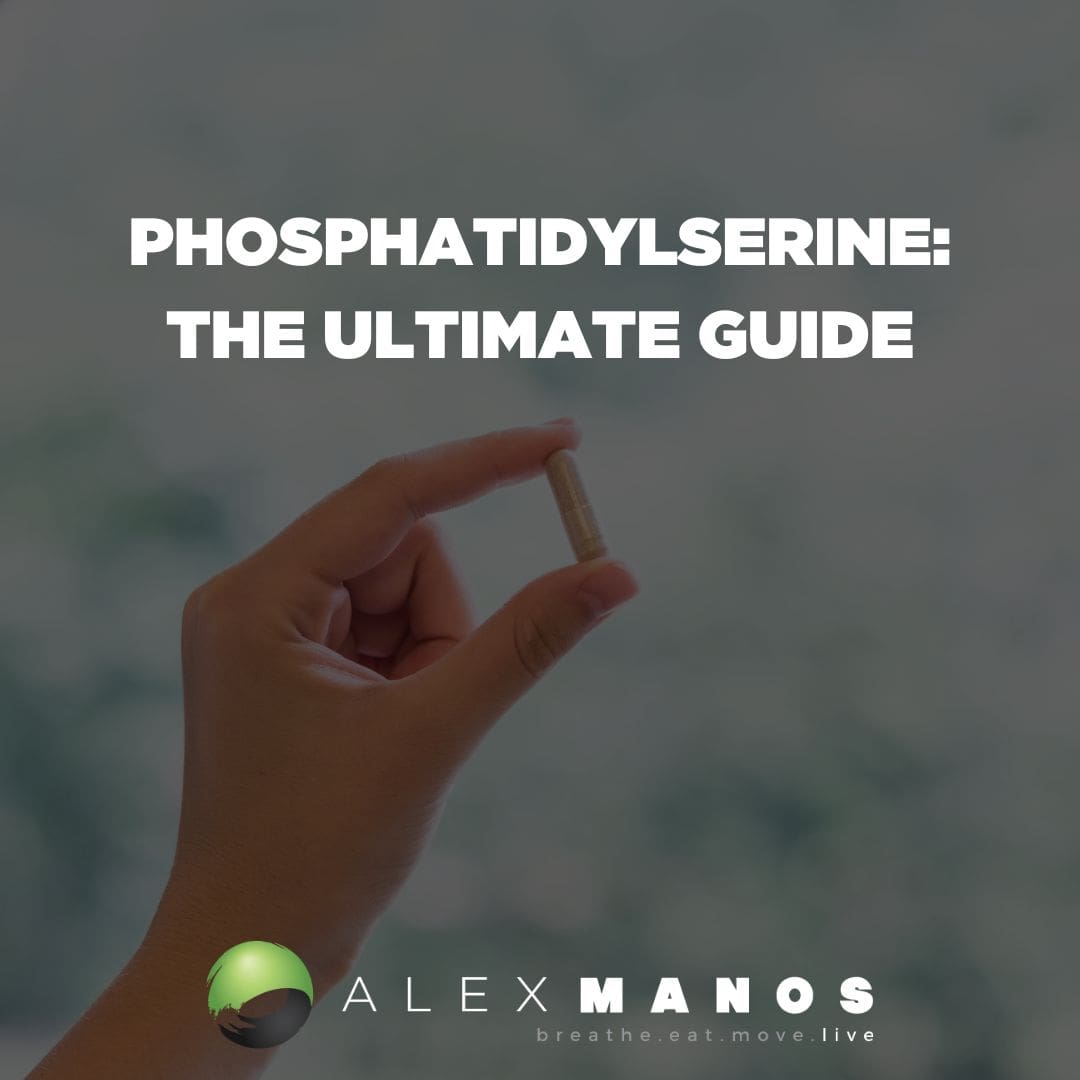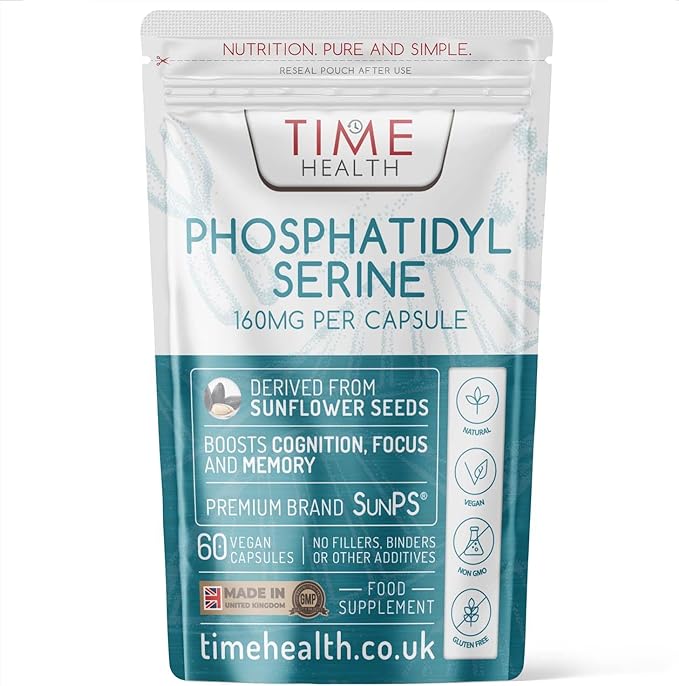Phosphatidylserine
Welcome to my blog on phosphatidylserine.
You may like to check out the section of my website “Supplement Spotlights” to learn about other supplements from medicinal mushrooms to ashwagandha or methylene blue.
What Is Phosphatidylserine?
Phosphatidylserine, one aminophospholipid molecular, is widely distributed among animals, plants, and microorganisms. It is a key component of mammalian cell double membranes and plays very important roles in biological processes such as apoptosis (cell death) and cell signaling. (source)
In the brain, phosphatidylserine comprises up to 15% of the total phospholipid pool. The fatty acid composition of endogenous PS depends on its locale and function in the cell.
Approximately 30 g of PS exists in the human body and about half of this amount (13 g) is found in brain tissues. (source)
Because of such potential importance in neuronal functioning, PS is informally characterized as a brain-specific nutrient.2 As PS within the neural membrane is especially important for the activation of protein kinase C (PKC) and PKC activity declines with age, it is speculated that there are age-related deficits in PS in humans. A decrease in PS in the brain with aging may relate to cognitive decline and impairment. (source)
Phosphatidylserine Foods
Small amounts are found in most foods.
Phosphatidylserine exists naturally in animals, plants, and microbial resources. The most commonly available sources of PS are soy and milk. Soy lecithin contains approximately 0.5% phosphatidylserine, whereas milk contains about 5%–10% of the total phospholipids. There are trace amounts of PS in vegetable oils such as corn oil, almond oil, and sunflower oil. (source)
Benefits Of Phosphatidylcholine
Many studies were conducted on the physiological functions of BC-PS. Nunzi et al. demonstrated that the administration of BC-PS improved the memory-related behaviours on aged rats. (source)
Alzheimer’s Disease
C-PS intake by elder people also showed a positive impact on the improvement of age-related brain dysfunction including Alzheimer’s disease.
Cenacchi et al. reported the improvements in behavioral and cognitive functions in a group of geriatric patients with cognitive impairment after BC-PS 300 mg/day for 6 months. (source)
Supplemental phosphatidylserine (200 mg/day for 3 months) significantly improved in memory, information processing, and the ability to perform activities of daily living for older patients with severe cognitive impairments secondary to Alzheimer’s disease. (source)
Age Related Memory Decline
Clinical studies on S-PS also showed positive effects on improving the age-related memory impairment. (source)
General Brain Health
Phosphatidylserine, when taken in doses ranging from 300 to 800 mg daily, is well absorbed by the body and can effectively cross the blood-brain barrier. It is safe and can slow down, stop, or even reverse biochemical changes and structural damage in nerve cells. This compound aids various cognitive functions in humans, such as forming short-term memories, consolidating long-term memories, creating new memories, retrieving stored memories, learning and recalling information, focusing attention, concentrating, reasoning, problem-solving, and developing language and communication skills. Additionally, it enhances locomotor functions, particularly in terms of quick reactions and reflexes. (source)
Depression
C-PS intake by elder people also showed a positive impact on the improvement of age-related brain dysfunction including depressive symptoms. (source)
Stress Alleviation
For healthy subjects, the brain performance and stress alleviation were improved after BC-PS intake.
The oral administration of BC-PS 800 mg/day for 10 days was demonstrated to significantly attenuate plasma cortisol concentrations in healthy inactive males. (source)
Psychiatric Disorders
The intake of phosphatidylserine has been associated with an improvement of psychiatric disorders, such as bipolar. (source)
ADHD
Moreover, phosphatidylserine significantly improved the attention-deficit hyperactivity disorder (ADHD) symptoms and the short-term auditory memory in children. phosphatidylserine supplement might be a safe and natural nutritional strategy for improving the mental performance in young children suffering from ADHD. (source)
Combating Exercise-Induced Stress
Intense physical activity generates reactive oxygen species in the body, leading to cellular damage and potentially causing cell death. Phosphatidylserine (PS) has been shown to be an effective supplement in mitigating exercise-induced stress and preventing the physiological decline associated with excessive training. (source)
PS has been demonstrated to speed up recovery, prevent muscle soreness, improve well-being, and might possess ergogenic properties in athletes involved in cycling, weight training, and endurance running. Fahey and Pearl reported that oral administration of S-PS (800 mg/day) during 2 weeks of intense weight training does not significantly attenuate creatine kinase activity but reduces the subjective ratings of muscle soreness during training. (source)
Short-term supplementation with S-PS (750 mg/day) improves exercise capacity during high-intensity cycling and tends to increase performance during intermittent running, indicating that phosphatidylserine might alter neuroendocrine function.
Additionally, a high cortisol response to exercise-induced stress can lead to negative training effects, such as overreaching or overtraining. Phosphatidylserine (PS) supplements have been shown to improve mood in some healthy young adults during stressful mental tasks and reduce both serum ACTH and cortisol levels. PS is recognized as a safe oral supplement that can lessen the serum cortisol and creatine kinase responses to acute exercise stress. Research indicates that taking a moderate dose of PS (600 mg/day) can help athletes maintain a favorable hormonal balance by reducing cortisol spikes. These findings suggest that PS helps mitigate the stress-induced activation of the hypothalamic-pituitary-adrenal axis. (source)
The Importance Of DHA
It’s important to note that about 20%-30% of phosphatidylserine in human gray matter consists of 1-stearoyl-2-docosahexaenoyl-sn-glycero-3-phosphoserine. The DHA content in neuronal phosphatidylserine is crucial for its function. Research by Cunnane et al. showed that decreasing DHA levels in phosphatidylserine is linked to the progression from mild cognitive impairment to Alzheimer’s disease. Therefore, the incorporation of phosphatidylserine into cell membranes depends on the availability of both PS and DHA. Sufficient amounts of DHA-enriched phosphatidylserine are necessary for the fusion of intraneuronal secretory granules with the presynaptic membrane, the release of neurotransmitters, and proper interaction with postsynaptic receptors. (source)
Phosphatidylserine And Omega 3 For Late Life Depression
When To Take Phosphatidylserine?
In most studies the dose was broken up and taken throughout the day. For example if taking 300mg per day you might take 100mg at breakfast, lunch, and dinner. If you are primarily using it for sleep then you may like to explore taking the full dose in the evening.
How Much Phosphatidylserine Per Day?
200-800mg/day has been used in clinical trials.
Alex is a certified Functional Medicine Practitioner (IFMCP) and has a MSc in Personalised Nutrition. He is also a breathwork facilitator with a background in personal training and massage therapy. He also runs The Resiliency Program - a 24 week program aimed at building physical, mental, emotional, and spiritual resilience.




